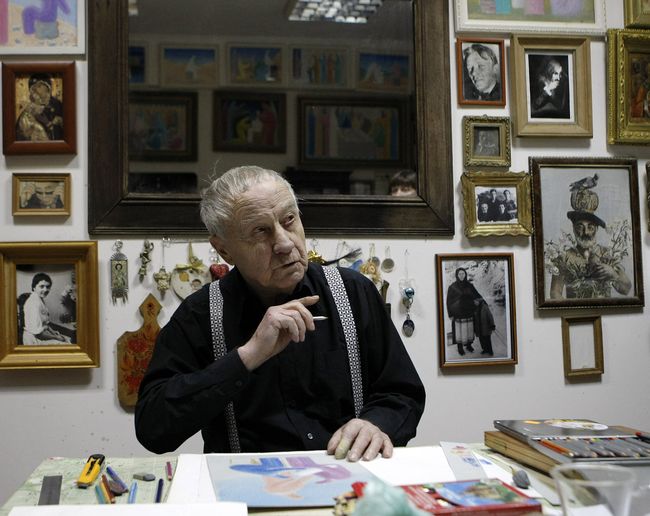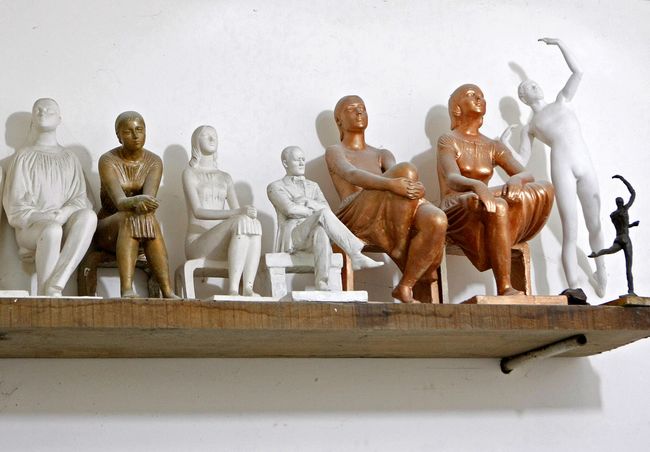“Thought and imagination are my freedom”
Mykola Rapai on the role of sculpture in a contemporary city
A decade ago Andriivsky Uzviz saw the unveiling of a unique monument to Mikhail Bulgakov, created by Mykola Rapai. Two decades ago he completed a conceptual series of painted illustrations to the New Testament. The legendary master’s works include original monuments, sculptures, memorial plaques, and portraits of outstanding personalities. Despite a respectable age (87), his eyes are as vivid as ever, and his brilliant mind and good-humored irony never change. Time has no power over Rapai, who never stopped his artistic career.
“REVEALING A PERSON IS A COMPLEX TASK, YET THIS IS THE BASIS OF A SCULPTURE’S ARTISTIC AND EXPRESSIVE VALUE”
You are best known as a portrait sculptor. What do you find of principal importance in this genre?
“My first task is to ensure portrait-like resemblance if I work on an image of a concrete person. First of all, they need to be recognizable. Second, to feel and reproduce my subject’s inner mood, to capture and render what is typical only of them and of no one else. I strive to notice details and nuances, and I mostly succeed in it, if we can believe the reviews. It is hard for someone to assess own work: one has to trust the reaction of colleagues, other professionals, and viewers.”
Who would be an easier model, a good acquaintance or a historical figure?
“I have sculpted on the bases of photos, molds, historical materials, which as a result allowed me to see the subject’s major personality traits, yet portraying of a living person is the most complicated and difficult task. For example, you are talking to me, and I have to sculpture you. It is extremely difficult to immediately reveal you and your essence and not what you would like to seem. After all, every person presents a desirable image of themselves, which may greatly differ from the real thing. This is typical of nearly everyone: the desire to present a better public image of oneself. A woman wants to be prettier, more charming, attractive, while for a man it is important to be more expressive, decisive, intelligent, and show a masculine character. After 10 or 15 sitting sessions the model’s essence is more clearly revealed; in the course of communication they often absolutely change and take off their mask. Revealing a person is a complex task, yet this is the basis of a sculpture’s artistic and expressive value. Without the person a sculpture will be dead and primitive. It can only affect souls when it expresses life.”
Which periods in the development of sculpture affected your world outlook, artistic career, and style?
“In my view, we see the culmination in Ancient Greek sculpture and in antique art in general. At some point in time the ancient achieved unbelievable heights in portraying man, in the execution of sculptural forms, in the process of generalization of beauty. They raised the plastic esthetic of sculpture to a whole new level. The only thing Greek sculpture can be reproached for is its self-elimination and artistic frigidity. Its outer form is the work of a genius and has been a paragon until this day, but it is devoid of inner life. Ancient Greek statues of gods and goddesses – Aphrodite, Artemis, or Zeus – are exalted and soulless. Their grandeur and plasticity are impressive, but the spectator remains aloof. Sculptors of subsequent periods made them more vivid. However, I learned the art of rendering form from Ancient Greeks because it felt intimate; I studied three-dimensional sculptures and copies in museums, and I learned on my own to work with the form.”

Which themes and images are close to you today? How did your tastes and views of art change with time?
“My views remain practically unchanged. Just like I always did, I believe that sculpture is a kind of art which is busy with very serious work. It has always faced a serious challenge: creating life in a real volume, in a real space, in a three-dimensional world. A sculptor can spend his whole life solving this primary problem, and yet never completely fathom its depth. All my life was dedicated to it, but today it seems to me that I hardly can do a thing. And I want to learn from scratch, although I realize how little time I have left. Grasping the depths of art, you arrive at a conclusion that you strive to reach an ever-elusive ideal. Actually, that is why a sculptor learns as long as he lives. And I still learn to draw, to solve color problems, and to work with volume.”
What are you doing now?
“Now I am not sculpting, I am only drawing what I see around: flowers or still lives. Working with sculpture is difficult because bronze or stone demand financial investment. There are concepts and ideas, but at present I cannot afford them.”
Have you often worked on commission?
“I mostly could choose myself what I liked and what interested me.”
To what extent is a sculptor free in his work?
“All art, sculpture included, suggests freedom. Another thing is, that often people try to abuse art, make a servant of it, and this is how prostitution of art comes to be. When art gives up its original freedom and begins, for instance, to serve and play up to politics, it stops being art. Even if I am given a theme, I am free as to how I am going to implement it: it is up to me to decide its composition, what it will look like, how it will move. This is my freedom, idea, imagination, and no one can ever impose on me from the outside. When I hear that I must do this or that, I say, ‘Do it yourself!’ And at that point we part. When I study a theme, I think it through, I feel it. And if I found a solution, it means that I believe it to be just. So if you trust me, we arrange that I execute it. If not, we part.”
“WE DO NOT KNOW WHAT JESUS AND MARY REALLY LOOKED LIKE”
What prompted you to take up Evangelical themes?
“I have a whole series of illustrations to the Bible. These are scenes from Christ’s life in chronology, from the Gospel and birth to the preaching to Passion and crucifixion [Rapai shows his drawings]. I based my works on the texts of Gospels according to Luke and Mark and partly to John. These Bible-based works have already been exhibited, and I will most likely exhibit them in the future.

“Quite by chance I found the Gospel themes in Chornobyl, where I went to draw immediately after the disaster. I was then flabbergasted by the emptiness and absence of life in the exclusion zone. An impressive sight was a group of physicists on the way to the reactor. They wore white and in a deserted city, among dead houses they resembled ghosts. It all looked so sinister: not a soul around, silence, heat, and only those white figures walking. My imagination reeled, and so an idea arose that Biblical characters have no faces. We do not know what Jesus and Mary really looked like. When we invent an image, it inevitably resembles something, and therefore realistic images of the saints are not true to life, they are wrong: no one knows what they looked like. Those who render them are liars. I created a faceless Christ and Mary, using the plasticity of motion to reveal the theme [looking at the drawings]. Here the Myrrhbearers are heading to the tomb early at dawn to anoint his body, only to discover that the tomb is empty. And here is the Wedding at Cana, where Jesus performed his first miracle by turning water into wine to treat all the guests present at the wedding banquet. By the way, I have been to Cana, this little village in the north of Judea not far from the Lake of Gennesaret. On a trip to Israel I was enchanted by that land, its spirit of old, the spirit of unbelievable Biblical antiquity. A fantastic country! There I not only confirmed the concept of my Biblical series, but also found realistic details. For instance, if I had not visited the Judean Desert, I would imagine it as a sea of sand dunes, while in reality it is a plain with hills, peaks, and rocks and sand among them. That is where Jesus Christ spent forty days contemplating about Himself, the time, and God the Father. Knowing precisely what this desert looks like, I made the drawing Jesus in the Desert.”
“A CITY NEEDS SCULPTURE OF PRECISE DIMENSIONS IN A PRECISE SPOT”
You are the author of a unique monument to Mikhail Bulgakov, placed outside the writer’s museum.
“When I read the first edition of The Master and Margarita, I was astonished by its author’s masterly artistic power. I loved the novel, with its beautifully developed Biblical theme. And I began working on the writer’s image, which lasted a very long time, nearly a decade. I made portraits, tried and changed a lot of things. And at last I created the last sketch of Bulgakov which, in my opinion, crowned all my contemplations of the writer. I simply kept all those sketches in my atelier until the last one was spotted by a representative of the government, and the government decided to erect a monument.”
So it simply lay there waiting for its time to come?
“Yes, waiting for an occasion. I saw that in art this has a huge importance. Studying the history of art and the biographies of my favorite Renaissance masters, Leonardo da Vinci and Michelangelo, I noticed how much their fates depended on an occasion. Actually their entire heritage is made of works of art that came to be due to a random chance, you see. For example, I had for a long time kept a sketch for the sculpture of Les Kurbas. The minister of culture liked it, the then mayor of Kyiv Omelchenko approved it, and we erected a monument to Kurbas.”
How do you see the role of sculpture in a contemporary city?
“This tradition is not established by us. For ages it has been customary to place sculptures of renowned persons of a country, of a nation: those who rose above all others. The role of sculpture here is considerable, but everything depends on where it is placed, how, and what the dimensions are. In Soviet times all these requirements were often neglected: they erected what and where they wanted, without much thought to it. And the sizes where colossal. I prefer modest dimensions. Urban sculpture must be a little over life-size, it must be close to the viewer who can compare himself to it and feel equal to it, human to human. The viewer must not stand in front of a deity, and that is why I am against huge sculptures which rise to the skies. A huge sculpture is monstrous, it is cold and unapproachable for a human being who cannot feel it, affect it, and this creates a subconscious repulsion. That is why a city needs sculpture of precise dimensions in precise spots.”
Newspaper output №:
№6, (2017)Section
Culture





